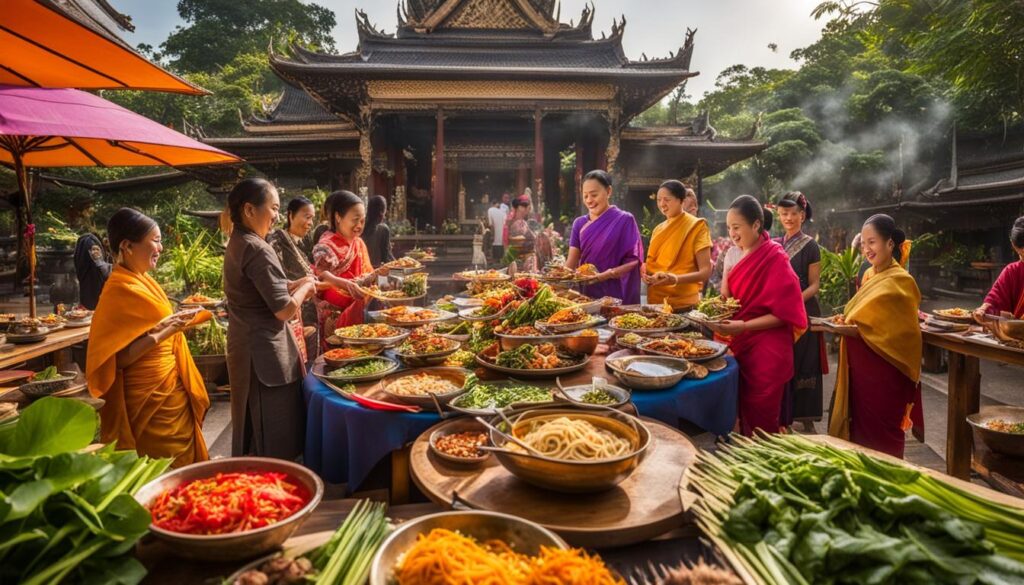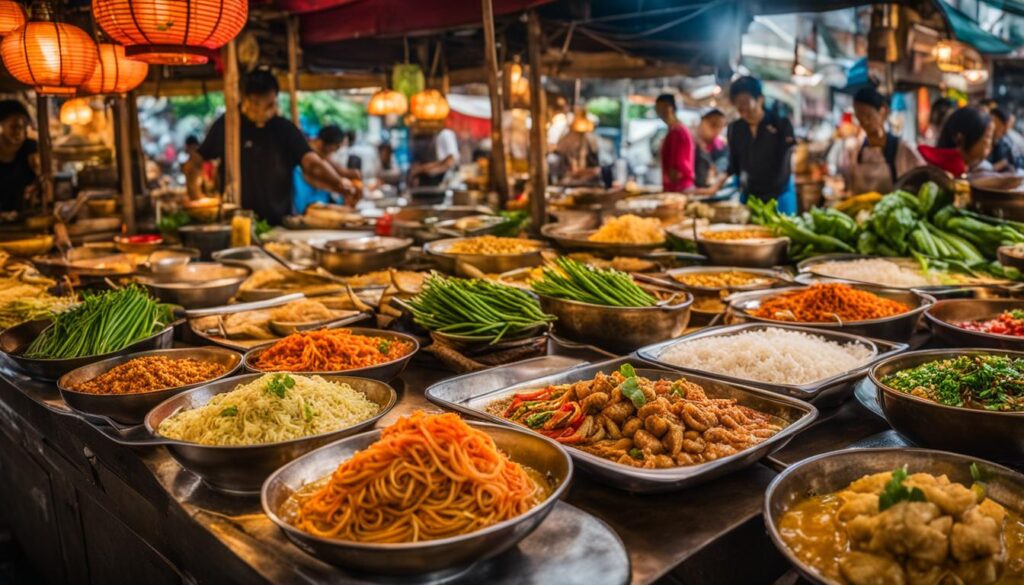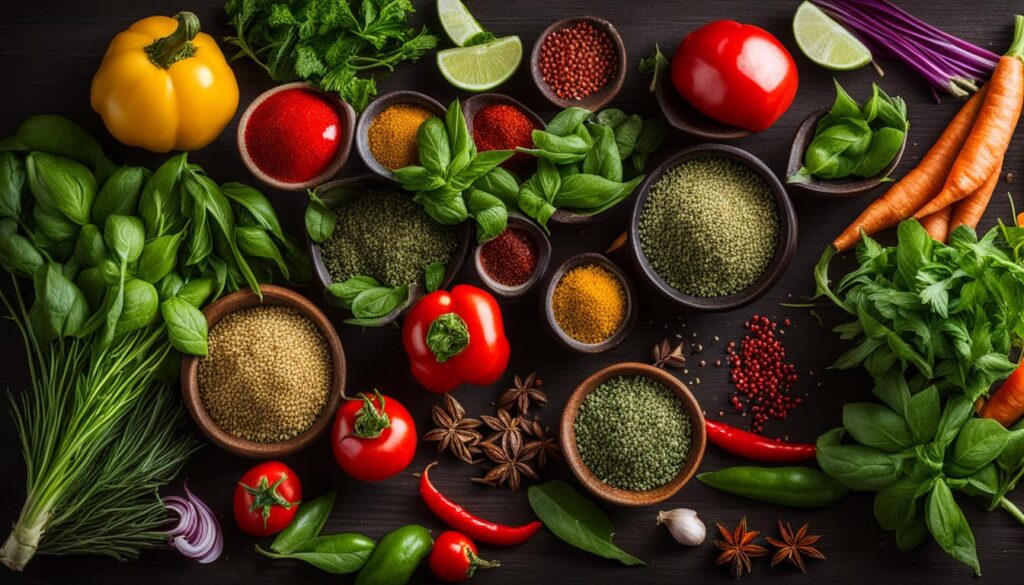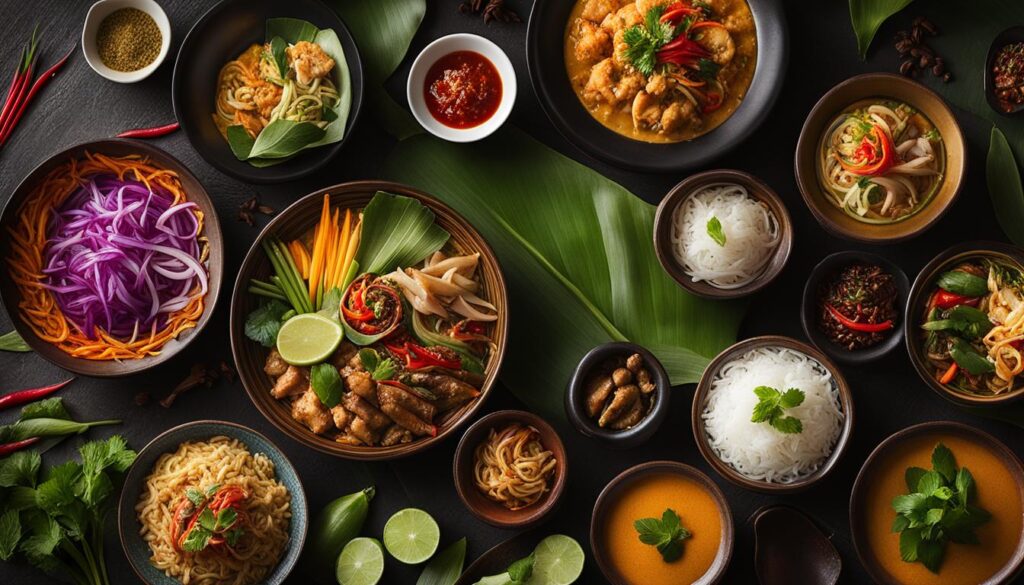Thailand has a long and rich history when it comes to its food. The Thai people originally migrated from Southern China over 2,000 years ago, bringing with them spicy cooking and rice. Throughout its history, Thailand has been influenced by neighbouring nations such as Vietnam, Cambodia, India, and Malaysia, resulting in a diverse and vibrant cuisine. Thai food is known for its unique combinations of seasonings, use of spices like lemongrass and ginger, and its balance of flavours, blending the elements of sweet, sour, salty, and spicy. Traditional Thai dishes include Tom Yum Soup, Pad Thai, Green Curry, and Massaman Curry.
Key Takeaways
- Thailand has a rich culinary history influenced by neighbouring nations.
- Thai cuisine is characterized by unique combinations of flavours and spices.
- Traditional Thai dishes include Tom Yum Soup, Pad Thai, Green Curry, and Massaman Curry.
- Thai cuisine balances the elements of sweet, sour, salty, and spicy flavours.
The Cultural Significance of Thai Cuisine
Food holds a central place in Thai culture and is often the focal point of social occasions and celebrations. Thai meals are typically shared and eaten communally, with each person taking a portion of each dish. The flavours of a typical Thai meal encompass all five main taste profiles – salty, sweet, sour, bitter, and spicy. In addition, food plays a significant role in traditional ceremonies and festivals, where offerings of food are made to spirits or monks. Thai cuisine is a reflection of the country’s rich cultural heritage and the influences of neighbouring countries.
In Thai culture, the presentation of food is considered as important as the flavours themselves. Thai cuisine is known for its exquisite presentation, with serving platters often decorated with intricately carved vegetables and fruits. Chefs are trained in the art of food carving to create visually appealing dishes. The attention to detail in food presentation pays homage to the respect Thai culture has for its ingredients and culinary traditions. The aesthetic aspect of Thai food enhances the overall dining experience, making it a feast for both the taste buds and the eyes.
Eating in Thailand is a communal experience, with meals typically shared among the diners. Traditional Thai meals consist of a variety of meat and/or fish dishes, alongside vegetables, noodles, and possibly soup. Thai people eat slowly and savour their food, taking the time to enjoy the experience and share it with loved ones. Thai cutlery consists of a fork and a large spoon, with the spoon used in place of a knife. The careful arrangement of food on the plate and the practice of eating one dish at a time reflect the respect and mindfulness that Thai people have towards their meals.

Evolution of Thai Cuisine
Thai cuisine has evolved over time, influenced by various periods in the country’s history. One significant period in Thai culinary development was the Ayutthaya period, which saw the royal court’s involvement in creating elaborate and sophisticated dishes. The Ayutthaya period also brought increased trade and contact with European traders, leading to the introduction of new ingredients and flavours into Thai cuisine.
The European influence on Thai food was particularly notable in the 19th century, with the introduction of chilli peppers from the Americas. This addition transformed Thai cuisine, giving it the spicy kick that it is known for today. Chilli peppers soon became a staple ingredient, incorporated into various Thai dishes to add depth and heat.
In recent years, there has been a growing trend of fusing Thai flavours with other international cuisines. This fusion of Thai flavours has resulted in unique and exciting dishes that combine the best of both worlds. For example, Thai-Mexican fusion dishes have gained popularity, combining the bold flavours of Thai cuisine with the vibrant ingredients and spices of Mexican cuisine. Thai-Japanese fusion is another popular trend, combining the delicate flavours of Japanese cuisine with the aromatic spices and herbs of Thailand.
| Period | Influence | Key Ingredients/Flavors |
|---|---|---|
| Ayutthaya period | Royal court influence | Elaborate dishes, sophisticated flavours |
| 19th century | European influence | Introduction of chilli peppers |
| Recent years | International fusion | Combining Thai flavours with other cuisines |
Regional Variations in Thai Cuisine
Thailand’s diverse landscape and climate have given rise to distinct regional variations in its cuisine. Each region boasts its own specialities and unique dishes, adding to the overall richness and diversity of Thai food. From the milder flavours of Northern Thai cuisine to the spicier and seafood-centric dishes of the South, there is something to tantalize every palate.
Northern Thai Food
In Northern Thailand, the cuisine is characterized by its use of fresh herbs and spices, resulting in delicate and aromatic flavours. The region’s cuisine is influenced by its proximity to Myanmar, Laos, and China. Popular dishes from this region include Khao Soi, a coconut-based curry noodle soup, and Sai Oua, a flavorful grilled herb sausage.
Southern Thai Food
Southern Thai food is known for its bold and spicy flavours, reflecting the region’s proximity to Malaysia and Indonesia. The cuisine makes extensive use of chilli peppers, coconut milk, and a wide variety of seafood. Dishes like Massaman Curry, a rich and flavorful curry with tender chunks of meat, and Tom Kha Gai, a spicy and tangy coconut chicken soup, are beloved examples of Southern Thai cuisine.
Central Thai Food
Central Thai food, often considered the most typical Thai cuisine, has its roots in the bustling city of Bangkok. This region’s cuisine showcases a harmonious blend of sweet, sour, salty, and spicy flavours, with an emphasis on herbs, spices, and coconut milk. Famous dishes from this region include Pad Thai, a stir-fried noodle dish, and Green Curry, a fragrant and spicy curry made with green chilli paste.

Exploring the regional variations in Thai cuisine allows one to appreciate the diversity and complexity of flavours that Thailand has to offer. Whether it’s the mild and aromatic dishes of the North, the spicy and bold flavours of the South, or the harmonious blend of tastes in Central Thai cuisine, each region contributes its unique culinary traditions to the vibrant tapestry of Thai food.
Key Ingredients in Thai Cuisine
Thai cuisine is renowned for its bold flavours, which are achieved through the use of key ingredients. Lemongrass, ginger, and kaffir lime leaves add distinctive citrusy, spicy, and aromatic flavours to dishes. Coconut milk is a common ingredient, used to add richness and creaminess to curries and soups. Fish sauce, made from fermented fish, is a staple in Thai cooking, providing a savoury and umami taste. These key ingredients, along with others such as chilli peppers and galangal, contribute to the unique and vibrant flavours of Thai cuisine.
Lemongrass is a signature ingredient in Thai cooking, known for its bright and refreshing citrus flavour. It is commonly used in dishes such as Tom Yum Soup and Green Curry. Lemongrass adds a zesty and aromatic note to the dish, enhancing the overall taste experience.
Ginger is another essential ingredient in Thai cuisine, adding a warm and slightly spicy flavour. It is often used in stir-fries, soups, and curries to add depth and complexity to the dish. Ginger also offers various health benefits, including aiding digestion and reducing inflammation.
Coconut milk is a versatile ingredient that is used in both sweet and savoury dishes. It adds a rich and creamy texture to curries and soups, while also providing a subtle sweetness. Coconut milk is a key component in popular Thai dishes such as Massaman Curry and Thai Green Curry.
Fish sauce, known as “nam pla” in Thai, is a vital ingredient in Thai cuisine, adding depth of flavour and saltiness to dishes. It is made by fermenting fish with salt, resulting in a complex and savoury taste. Fish sauce is used in a variety of dishes, from salad dressings to stir-fries, and is considered the “soul” of Thai cooking.

The combination of these key ingredients, along with the careful use of spices and herbs, creates the distinctive and vibrant flavours that Thai cuisine is known for. Whether it’s the tanginess of lemongrass, the warmth of ginger, or the creaminess of coconut milk, these ingredients work together to create a harmonious balance of flavours. Thai cuisine truly offers a sensory experience like no other.
The Importance of Presentation in Thai Cuisine
In Thai culture, the presentation of food is considered as important as the flavours themselves. Thai cuisine is known for its exquisite presentation, with serving platters often decorated with intricately carved vegetables and fruits. Chefs are trained in the art of food carving to create visually appealing dishes. The attention to detail in food presentation pays homage to the respect Thai culture has for its ingredients and culinary traditions. The aesthetic aspect of Thai food enhances the overall dining experience, making it a feast for both the taste buds and the eyes.

Thai cuisine places a strong emphasis on the visual appeal of dishes, with vibrant colours and creative arrangements. The careful placement of ingredients and the use of garnishes create a visually stunning plate that entices diners even before they take their first bite. Thai food presentation is often described as a work of art, with each dish meticulously crafted to showcase the balance and harmony of flavours.
Additionally, Thai food presentation reflects cultural beliefs and customs. The use of certain ingredients and the arrangement of dishes can symbolize auspicious meanings or represent specific occasions. For example, a dish with a centrepiece of carved vegetables may be prepared for a special celebration or festival. This attention to symbolic meanings adds another layer of depth to the dining experience.
The Role of Scent in Thai Food Presentation
In Thai cuisine, the presentation of food goes beyond visual appeal. The aromas emitted by the dishes are also carefully considered and play a significant role in the overall experience. Fragrant ingredients like lemongrass, kaffir lime leaves, and Thai basil are used to infuse the dishes with delightful scents. The combination of these aromatic elements creates a sensory experience that is captivating and enticing.
| Thai Food Presentation Techniques | Descriptions |
|---|---|
| Garnishing |
|
| Colourful Arrangements |
|
| Balance and Symmetry |
|
| Use of Serving Vessels |
|
“Thai food is not only a feast for the palate but also a feast for the eyes. The artful presentation of dishes adds to the overall dining experience and reflects the cultural significance of Thai cuisine.”
The importance of food presentation in Thai culture goes beyond aesthetics. It is a reflection of the Thai people’s deep connection to their culinary heritage and their appreciation for the beauty of nature. Whether dining at a high-end restaurant or enjoying street food, the visual appeal of Thai cuisine adds an extra layer of enjoyment to the dining experience, making it truly unforgettable.
Eating Etiquette and Traditions in Thai Cuisine
In Thailand, dining is not just about satisfying hunger but also a social experience that emphasizes communal sharing and appreciation for food. Traditional Thai meals are typically enjoyed with family and friends, bringing people together to savour the flavors and bond over a shared culinary experience.
Communal dining is a common practice in Thailand, where dishes are placed in the centre of the table and everyone helps themselves to a variety of dishes. This style of dining encourages interaction and fosters a sense of togetherness. Thai people believe that sharing food fosters unity and creates a warm and inviting atmosphere.
Thai meals are often a combination of different dishes, including various meats or seafood, vegetables, noodles, and soups. Each dish is carefully prepared with a balance of flavours, incorporating the key elements of Thai cuisine: sweet, sour, salty, and spicy. The careful arrangement of food on the plate and the practice of eating one dish at a time allows diners to fully appreciate the different flavours and textures.
In traditional Thai dining, Thai cutlery plays a unique role. Instead of using a knife, Thai people use a spoon and fork. The fork is used to push the food onto the spoon, which is then used to bring the food to the mouth. This style of eating reflects the cultural influence of neighbouring countries like China and India, where chopsticks and hands are commonly used for eating.
The Importance of Thai Cutlery
“Thai cutlery is not only a practical tool for eating, but it also reflects the cultural values of Thai people. The use of a spoon and fork signifies a sense of refinement and respect for the food being enjoyed. It also allows diners to savor the flavors of each dish without overpowering them.”
Thai cutlery has a significant impact on the dining experience. It allows for ease of handling and ensures that the flavours of each dish are maintained, as the use of a knife could potentially alter or mask the taste. The Thai cutlery tradition is deeply rooted in Thai culture and continues to be practised in both formal and casual settings.
Overall, Thai cuisine is not only about the delicious flavours and unique combinations of ingredients. It is also about the cultural significance of community, sharing, and respect for food. The communal dining experience, traditional Thai meals, and the use of Thai cutlery all contribute to the distinctive dining etiquette and traditions that make Thai cuisine a truly immersive and memorable experience.

| Communal Dining in Thailand | Traditional Thai Meals | Thai Cutlery |
|---|---|---|
| In Thailand, dining is a communal experience, with meals typically shared among the diners. | Traditional Thai meals consist of a variety of meat and/or fish dishes, alongside vegetables, noodles, and possibly soup. | Thai cutlery consists of a fork and a large spoon, with the spoon used in place of a knife. |
| Communal dining fosters a sense of togetherness and unity. | Thai meals are carefully prepared with a balance of flavours, incorporating the key elements of Thai cuisine. | The use of Thai cutlery reflects a sense of refinement and respect for food. |
| Thai people believe that sharing food brings people closer and creates a warm and inviting atmosphere. | Arranging food on the plate and eating one dish at a time allows for a full appreciation of flavours. | Thai cutlery ensures that the flavours of each dish are maintained and not overpowered. |
Snacking and Street Food Culture in Thailand
Thailand’s vibrant street food culture and variety of quick and delicious snacks make it a haven for food enthusiasts. From bustling food markets to roadside stalls, the streets of Thailand are filled with intoxicating aromas and an endless array of mouth-watering treats.
Popular Thai snacks include crispy spring rolls, succulent satay skewers, and flavorful spicy dips. These snacks are often made with fresh ingredients and aromatic spices, providing a burst of flavours in every bite. Whether you’re craving something savoury, spicy, or sweet, Thai street food has something to satisfy every palate.
The beauty of Thai street food lies in its accessibility and affordability. Locals and tourists alike flock to street food vendors to indulge in a quick and satisfying meal or snack on the go. The vibrant and bustling atmosphere adds to the overall experience, immersing visitors in the sights, sounds, and tastes of Thailand.
| Popular Thai Street Food | Description |
|---|---|
| Pad Thai | A classic stir-fried noodle dish with a perfect balance of sweet, sour, and savoury flavours. |
| Som Tam | A refreshing and tangy green papaya salad, often made with chilli, lime, and peanuts. |
| Moo Ping | Tender and juicy grilled pork skewers marinated in a blend of herbs and spices. |
| Mango Sticky Rice | A delightful dessert made with fragrant sticky rice, fresh mango slices, and coconut milk. |
Thai street food is not only delicious, but it also offers a glimpse into the local culture and culinary traditions. It is an integral part of Thai life, bringing people together to share and enjoy good food. So, the next time you visit Thailand, be sure to explore the streets and savour the flavours of this vibrant street food culture.

Conclusion
Thai cuisine is a celebration of Thailand’s rich culinary heritage, showcasing the country’s history, geography, and cultural traditions. With its diverse regional variations and the blending of flavours and techniques from neighbouring countries, Thai food offers a delightful journey for the taste buds.
From the spicy and aromatic dishes of Northern Thailand to the bold and flavorful seafood dishes of the South, Thai cuisine captivates food lovers with its unique combination of flavours, balance, and harmony. The use of key ingredients such as lemongrass, ginger, and coconut milk adds depth and complexity to the dishes, while the attention to food presentation reflects the respect Thai culture has for its ingredients and culinary traditions.
As Thai cuisine continues to evolve, embracing new ingredients and cooking techniques, it retains its traditional flavours and techniques. The result is a vibrant culinary landscape that caters to both traditionalists and those seeking innovative Thai fusion creations. With its rich variety and tantalizing flavours, Thai food is sure to leave a lasting impression on anyone who experiences it, truly demonstrating the diversity of Thailand’s culinary heritage.
FAQ
What is the history of food in Thailand?
Thai food has a long and rich history, with influences from Southern China and neighboring countries like Vietnam, Cambodia, India, and Malaysia. It has evolved over time with influences from different periods in history, including European influences in the 19th century. Today, Thai cuisine continues to embrace new ingredients and cooking techniques while retaining its traditional flavors and techniques.
What are some traditional Thai dishes?
Traditional Thai dishes include Tom Yum Soup, Pad Thai, Green Curry, and Massaman Curry. These dishes showcase the unique combinations of seasonings, use of spices like lemongrass and ginger, and the balance of flavors that Thai cuisine is known for.
How does Thai cuisine vary regionally?
Thailand’s diverse landscape and climate have contributed to the development of regional variations in Thai cuisine. Northern Thai food is characterized by the use of herbs and spices, while Southern Thai food is known for its spiciness and seafood. Central Thai food is often considered the most typical, with an emphasis on herbs, spices, and coconut milk.
What are some key ingredients in Thai cuisine?
Key ingredients in Thai cuisine include lemongrass, ginger, coconut milk, fish sauce, and kaffir lime leaves. These ingredients contribute to the unique and vibrant flavors of Thai dishes.
How is food presented in Thai cuisine?
Thai cuisine is known for its exquisite presentation, with serving platters often decorated with intricately carved vegetables and fruits. Chefs are trained in the art of food carving to create visually appealing dishes.
What are some eating traditions in Thai cuisine?
Eating in Thailand is a communal experience, with meals typically shared among the diners. Thai people eat slowly and savor their food, taking the time to enjoy the experience and share it with loved ones. Thai cutlery consists of a fork and a large spoon, with the spoon used in place of a knife.
What is Thai street food culture like?
Thailand is famous for its vibrant street food culture. Street food vendors offer a range of quick and delicious snacks, such as spring rolls, satay, and spicy dips. Thai culture embraces snacking, and it is common to find affordable and tasty snacks along the roadside or at marketplaces.
What is the significance of Thai cuisine in Thai culture?
Thai cuisine is a celebration of Thailand’s rich culinary heritage, influenced by its history, geography, and cultural traditions. It reflects the country’s regional variations and the blending of flavors and techniques from neighboring countries. Thai food holds a central place in social occasions and celebrations, and it is a reflection of Thai people’s respect for their ingredients and culinary traditions.
Is Thai cuisine popular outside of Thailand?
Yes, Thai cuisine is popular worldwide for its bold and vibrant flavors. Thai restaurants can be found in many countries, and Thai dishes are often praised for their unique and delicious taste. Thai cuisine continues to captivate food lovers around the world.
Source Links
- https://www.thespruceeats.com/thai-food-and-culture-3217393
- https://oldwayspt.org/blog/traditional-asian-diet-spotlight-thailand
- https://kisskisseatery.com/exploring-the-history-and-culture-of-thai-cuisine/



